Search us!
Search The Word Detective and our family of websites:
This is the easiest way to find a column on a particular word or phrase.
To search for a specific phrase, put it between quotation marks. (note: JavaScript must be turned on in your browser to view results.)
Ask a Question! Puzzled by Posh?
Confounded by Cattycorner?
Baffled by Balderdash?
Flummoxed by Flabbergast?
Perplexed by Pandemonium?
Nonplussed by... Nonplussed?
Annoyed by Alliteration?

Don't be shy!
Send in your question!
Columns from 1995 to 2006 are slowly being added to the above archives. For the moment, they can best be found by using the Search box at the top of this column.
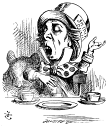 If you would like to be notified when each monthly update is posted here, sign up for our free email notification list.
If you would like to be notified when each monthly update is posted here, sign up for our free email notification list.
Trivia
All contents herein (except the illustrations, which are in the public domain) are Copyright © 1995-2020 Evan Morris & Kathy Wollard. Reproduction without written permission is prohibited, with the exception that teachers in public schools may duplicate and distribute the material here for classroom use.
Any typos found are yours to keep.
And remember, kids,
Semper Ubi Sub Ubi
|
To serve and hornswoggle.
Dear Word Detective: I recently visited Williamsburg,VA, where, while eating at a restaurant, I noticed that the fork only had three prongs. I made a mention of it to the waiter and they proceeded to tell me that I was eating with a “threek,” and that a fork had four prongs, a “took” had two prongs, and no civilized person would ever eat using a one-pronged fork, called “a stick.” The reasoning seems to make sense, but was this server correct? — David Thompson.
Oh boy, here we go again. Someday, when I am rich (ha) and have nothing better to do, I’m going to travel the world, visiting “historic” tourist attractions and asking innocent questions such as the one you posed. Then, when the waiter or “cowherd” or “blacksmith” feeds me a ridiculous fable, I’m going to smack the miscreant with a trout. I’m not sure why these places make sure they get the wigs and bustles just right, but think it’s perfectly fine to invent insane language lore.
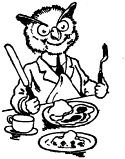 So no, the waiter was was dispensing pure, unvarnished flapdoodle. Incidentally, many of my favorite foods come on a stick. Mmmm, fishsicles! So no, the waiter was was dispensing pure, unvarnished flapdoodle. Incidentally, many of my favorite foods come on a stick. Mmmm, fishsicles!
The entire edifice of deceit foisted upon your innocent tourist soul by that duplicitous waiter rests on one feeble assumption: that the word “fork” has something to do with “four.” It doesn’t. “Fork” comes from the Old English “forca,” which in turn is rooted in the Latin “furca,” meaning “pitchfork.” In English, “fork” referred to pitchforks and similar agricultural implements until the 15th century. Use of the fork in England didn’t really become common until the 18th century (other parts of the world had adopted it earlier), the knife and spoon being the primary dining implements (along with the fingers) before then.
The number of tines on a dining fork has varied over the centuries, and although four-tined forks are most common today, three- or even two-tined variants (for dealing with pickles, shrimp, etc) are not uncommon. The terms “threek” and “took,” however, are almost certainly inventions of public-relations pixies of the sort lurking behind the scones, so to speak, at Williamsburg, and do not occur in any established dictionary. That doesn’t mean that no one ever uses the terms, just that not enough people do to make them “common.”
Two other “fork-like” implements do bear their own names. One is the “trident,” the three-tined spear carried by the Greek sea god Poseidon. The other is the “spork,” a cross between a spoon and a fork (essentially a spoon with three or four short tines at the tip). Sporks date back to the 19th century, and the name has been the subject of trademark litigation pretty much constantly since then, but we will probably never know who actually invented the gizmo.
Like, wow.
Dear Word Detective: I’m trying to find the word the describes the following examples: When you decide to buy a red minivan then suddenly you notice all the red minivans driving around you, or when you plant a flower in your yard then suddenly you notice all the yards with the same flower planted. I’ve heard it in a seminar but can’t remember any part of the word. –Judy Ewens.
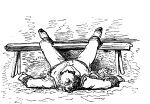 Good question. I believe the word you’re looking for is “suburbia.” More than just a locale on the fringes of big cities, “suburbia” is actually a discrete state of mind, a subset of the Jungian “collective unconscious,” manifested in rigid herd behavior. Today it might be red minivans, fifteen years ago it was those stupid “Baby on Board” signs in every car, tomorrow it’ll be, oh, epaulets on pajamas or something equally pointless. Might as well get with the program and line up for your iPhone. Good question. I believe the word you’re looking for is “suburbia.” More than just a locale on the fringes of big cities, “suburbia” is actually a discrete state of mind, a subset of the Jungian “collective unconscious,” manifested in rigid herd behavior. Today it might be red minivans, fifteen years ago it was those stupid “Baby on Board” signs in every car, tomorrow it’ll be, oh, epaulets on pajamas or something equally pointless. Might as well get with the program and line up for your iPhone.
Just kidding. The word you want is probably “synchronicity,” which is sort of a coincidence on steroids. The word was coined by the Swiss psychologist Carl Jung, to describe, as the Oxford English Dictionary puts it, “the phenomenon of events which coincide in time and appear meaningfully related but have no discoverable causal connection.” A “synchronicity,” from the Greek “synchronos” meaning “happening at the same time,” is a coincidence that seems far too finely tuned to be mere coincidence.
One of the examples of synchronicity cited by Wikipedia (and apparently verified by multiple sources) is a genuine stunner: “During production of The Wizard of Oz, a coat bought from a second-hand store for the costume of Professor Marvel was later found to have belonged to L. Frank Baum, author of the children’s book upon which the film is based.” Ooooeeeooo.
Jung felt that such “synchronicities” were evidence of an underlying pattern or mechanism in human existence and, perhaps, even evidence of a “collective unconscious” shared by all people. Whatever the explanation, most of us have had at least a mild experience of the phenomenon. A few years ago I was reading an essay on the Russian author Anton Chekhov as I waited on a subway platform in New York City. I had just read Chekhov’s famous line “You ask, ‘What is life?’ That is like asking, ‘What is a carrot?’ A carrot is a carrot, and nothing more is known about it,” when the train entered the station. Glancing up, I noticed that the motorman was, improbably but unmistakably, eating a large orange carrot.
Ow, my brains!
Dear Word Detective: I often have heard, and have used, the term “smart,” in reference to hurting, as in “Boy, that really smarts.” Is this in any way related to “smart” as an assessment of one’s knowledge? — Van Neie.
 As in “I guess trimming my toenails with tin snips wasn’t very smart, because this really smarts”? Good question, and the fact that a sentence like that wouldn’t set off alarm bells in most of our noggins is a tribute to the remarkable ability of the English language to use what appears to be the same word to mean two very different things. Or maybe it means that we’re just not really paying close attention to what we say. As in “I guess trimming my toenails with tin snips wasn’t very smart, because this really smarts”? Good question, and the fact that a sentence like that wouldn’t set off alarm bells in most of our noggins is a tribute to the remarkable ability of the English language to use what appears to be the same word to mean two very different things. Or maybe it means that we’re just not really paying close attention to what we say.
It wouldn’t be surprising to learn that “smart” (learned) and “smart” (pain) are actually two different words from unrelated sources. English is full of such homonyms, words spelled (and often pronounced) the same but with different meanings and different origins. One classic example is the word “fluke,” which can mean a kind of flounder-like fish, the fins on a whale’s tail, the pointy bits on the end of a ship’s anchor, or a stroke of good luck. All those “flukes” come from different sources; English evolved “fluke” four separate times, much as the wings of bats evolved entirely independently from those of birds.
“Smart,” however, is one of those cases where the two primary senses, even though they seem hard to connect to each other, share a common origin. “Smart” meaning “hurt” is actually the grandparent of “smart” meaning “on the ball.” It’s the same word.
The source of “smart” is the prehistoric Germanic root word “smert,” which meant “to be painful; to hurt,” and which eventually produced our modern English “smart.” As a verb, “to smart” has always meant “to hurt,” usually literally, although later uses have invoked the word in a figurative sense (“The fact that it was his own mother who fingered him to the IRS was what really smarted”).
It was when “smart” the verb begat “smart” the adjective that things really started to get interesting. The earliest use of “smart” as an adjective was to mean literally “causing pain, stinging,” as one might speak of a “smart” lash with a whip. But by around 1300, “smart” was also being applied figuratively to “sharp” or “cutting” remarks (“He seldom failed of a smart word or two upon my littleness,” Swift, 1726). This led to “smart” being used to mean “strong, quick, intense” in manner, which led, by the 17th century, to the word being used to mean “clever,” “witty” or “knowledgeable.” The sense of “smart” people being quick, witty and fashionable led shortly thereafter to the use of “smart” to also mean “neatly attired” and “trim.”
|
Makes a great gift! Click cover for more.  
400+ pages of science questions answered and explained for kids -- and adults!
FROM ALTOIDS TO ZIMA, by Evan Morris
 
|
 So no, the waiter was was dispensing pure, unvarnished flapdoodle. Incidentally, many of my favorite foods come on a stick. Mmmm, fishsicles!
So no, the waiter was was dispensing pure, unvarnished flapdoodle. Incidentally, many of my favorite foods come on a stick. Mmmm, fishsicles!
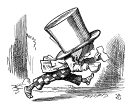
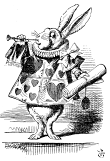 can be found
can be found 
 Good question. I believe the word you’re looking for is “suburbia.” More than just a locale on the fringes of big cities, “suburbia” is actually a discrete state of mind, a subset of the Jungian “collective unconscious,” manifested in rigid herd behavior. Today it might be red minivans, fifteen years ago it was those stupid “Baby on Board” signs in every car, tomorrow it’ll be, oh, epaulets on pajamas or something equally pointless. Might as well get with the program and line up for your iPhone.
Good question. I believe the word you’re looking for is “suburbia.” More than just a locale on the fringes of big cities, “suburbia” is actually a discrete state of mind, a subset of the Jungian “collective unconscious,” manifested in rigid herd behavior. Today it might be red minivans, fifteen years ago it was those stupid “Baby on Board” signs in every car, tomorrow it’ll be, oh, epaulets on pajamas or something equally pointless. Might as well get with the program and line up for your iPhone. As in “I guess trimming my toenails with tin snips wasn’t very smart, because this really smarts”? Good question, and the fact that a sentence like that wouldn’t set off alarm bells in most of our noggins is a tribute to the remarkable ability of the English language to use what appears to be the same word to mean two very different things. Or maybe it means that we’re just not really paying close attention to what we say.
As in “I guess trimming my toenails with tin snips wasn’t very smart, because this really smarts”? Good question, and the fact that a sentence like that wouldn’t set off alarm bells in most of our noggins is a tribute to the remarkable ability of the English language to use what appears to be the same word to mean two very different things. Or maybe it means that we’re just not really paying close attention to what we say.



Recent Comments